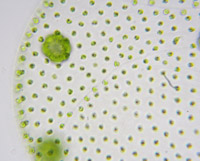Observing life from a pond
Materials
- Glass microscope slides
- Plastic cover slips
- Paper towels or tissues
- Samples of protists and/or volvox
- Plastic pipette or dropper
See information on suppliers here.
Methods
- Place a drop of pond water or commercially bought Volvox or protozoa on a microscope slide with a pipette or dropper.
TIPS:
- Too small a drop may result in the specimens being crushed, so be prepared to make another slide if necessary.
- Larger volvox can be prevented from being crushed using a chamber made of tape.
- A stereomicroscope may be helpful to find organisms for transferring to a slide.
- Place a coverslip on top and observe
The phytoplankton in the oceans produces most of the oxygen of the Earth's atmosphere – about half of the total amount produced by all plant life.
 Protists or Protozoa are a diverse group of eukaryotic microorganisms. They often have little in common besides a relatively simple organisation: either they are unicellular, or they are multicellular without specialised tissues (e.g. Volvox). Many protists are photosynthetic and are vital primary producers in ecosystems, particularly in the ocean as part of the plankton (phytoplankton). Other protists, such as the Kinetoplastids and Apicomplexa, are responsible for a range of serious human diseases, such as malaria and sleeping sickness. Please find attached supplemental information on pond life (click here).
Protists or Protozoa are a diverse group of eukaryotic microorganisms. They often have little in common besides a relatively simple organisation: either they are unicellular, or they are multicellular without specialised tissues (e.g. Volvox). Many protists are photosynthetic and are vital primary producers in ecosystems, particularly in the ocean as part of the plankton (phytoplankton). Other protists, such as the Kinetoplastids and Apicomplexa, are responsible for a range of serious human diseases, such as malaria and sleeping sickness. Please find attached supplemental information on pond life (click here).

